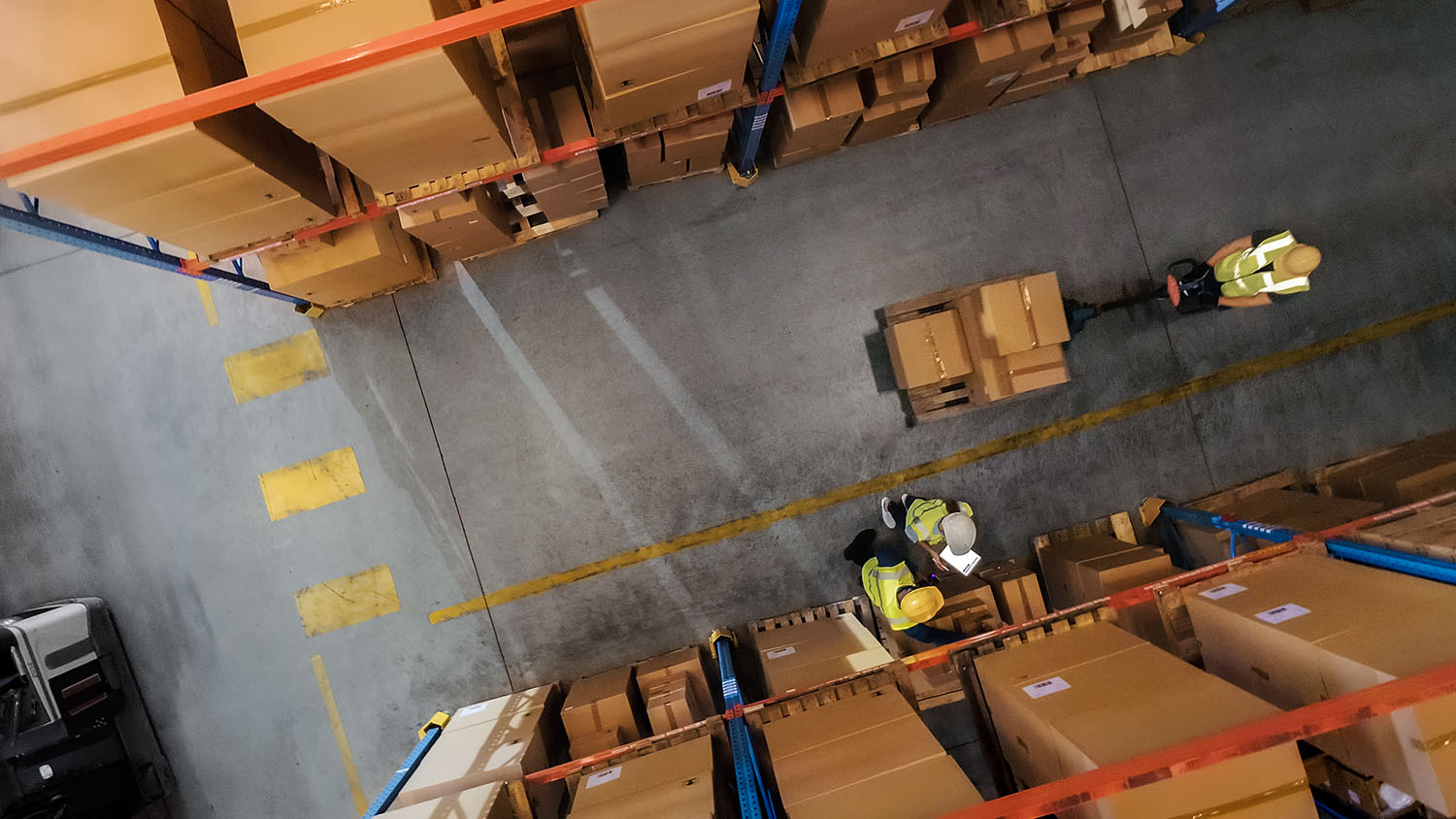Your warehouse’s success comes down to one critical decision—choosing the best WMS systems.
Get it right, and you’ll turn operational headaches into growth opportunities.
Get it wrong, and watch your competition say “yes” to opportunities you’re forced to turn away.
Warehouse operations in 2025 look nothing like they did five years ago.
Customer demands for faster deliveries and seamless experiences aren’t just rising—they’re exploding. A study by Ipsos-Octopia reveals that 85% of online shoppers consider delivery time important or very important, with 57% expecting same-day or next-day delivery options.
One missed shipment, delayed order, or inventory mistake can cost you a customer for life.
Modern warehouses aren’t just storage spaces anymore. They’re high-stakes command centers where millions of decisions happen daily. From receiving to shipping, every movement counts.
In this article, we’ll round up seven of the best WMS systems in 2025 that you should consider purchasing for your business.
What is a Warehouse Management System (WMS)?
A Warehouse Management System (WMS) is software that manages and controls all warehouse operations, from the moment goods enter your facility until they are shipped to customers.
At its core, it’s the central system that gives you real-time visibility into every aspect of your warehouse operations and inventory, including:
- Complete inventory tracking and management
- Order receiving and processing
- Picking and packing workflows
- Resource planning and allocation
- Shipping coordination
While basic systems leave you battling spreadsheets and manual processes, modern WMS systems lets you ship faster, handle more orders, and grow your business without adding overhead.
What to Look for in a Warehouse Management System?
Choosing the right WMS is like laying the foundation for a skyscraper—it has to be rock solid and built to support your growth. But, choosing one that matches your business needs can be challenging.
Here are a few features to look out for while purchasing a WMS:
- Cloud-Based Architecture: Skip the headache of expensive servers and manual updates. Your WMS should give you secure, anywhere access to real-time data while handling upgrades automatically.
- Flexibility That Fits: Your WMS should adapt to how you work—not force you to change your entire operation. Look for systems that let you configure workflows without expensive custom coding.
- Real-Time Insights: Every team member needs instant answers about inventory, orders, and performance. Your WMS should turn complex data into clear actions that prevent costly mistakes.
- Seamless Integrations: Your WMS needs to play nice with your entire tech stack—from accounting to customer systems. Make sure the WMS you choose integrates with critical systems like ERP, CRM, e-commerce platforms, and shipping carriers to create a unified, efficient ecosystem.
- Automation Capabilities: Your WMS should handle the heavy lifting—automating tasks like picking, packing, and barcode scanning—so your team can work smarter, not harder.
- Rock-Solid Support: Issues happen. When they do, you need answers in minutes, not days. Choose a provider known for quick, expert support that keeps you moving.
- Security and Compliance: Your data is your business’s lifeline, and keeping it safe is non-negotiable. A reliable WMS should have strong data encryption, role-based access, and compliance with industry standards to protect sensitive information.
7 Best WMS Systems
1. Da Vinci
WMS is a cloud-based Warehouse Management System (WMS) tailored to meet the complex needs of modern businesses, including third-party logistics providers (3PLs). It’s designed for flexibility and scalability. And excels in handling diverse product types and operational challenges.
With seamless cloud functionality, advanced billing automation, and a self-service configuration model, Da Vinci offers a cost-effective alternative to Tier 1 systems without compromising on features, functionality, or service.
It’s ideal for businesses looking to scale their operations and streamline processes without the high costs associated with traditional Tier 1 solutions.
Features
- Cloud-based architecture with real-time updates and secure data storage
- Advanced billing automation tailored for 3PL operations
- Barcode scanning for accurate inventory management and order tracking
- Smart shipping integration with automated rate shopping and cost optimization
- Configurable workflows for diverse product types and operational needs
- Pick-and-pack optimization with wave processing and auto-cartonization
- Comprehensive reporting tools with real-time dashboards and analytics
- Integration with ERP, TMS, and e-commerce platforms
- Scalable design to accommodate business growth and complexity
- User-friendly interface for easy adoption and training
Pros
- Offers Tier 1 functionality at a fraction of the cost
- Highly configurable without requiring custom coding
- Exceptional billing features reduce errors and save administrative time
- Rapid deployment, with businesses going live in as little as 60–90 days
- Outstanding customer support and tailored training resources
- Robust real-time reporting and analytics improve decision-making
Cons
- May be overly advanced for simple operations like pallet-in, pallet-out workflows
- Advanced features can take time to fully explore, but tailored training ensures teams quickly unlock the system’s full potential
2. SnapFulfil
Next up is SnapFulfil—a cloud-based, Tier 1 WMS developed by Synergy Logistics that caters to various industries, including retail, e-commerce, 3PLs, manufacturing and food and beverage.
The system is built with flexibility in mind. This makes it a good choice for businesses with evolving needs, from single-site operations to more complex multi-location setups.
SnapFulfil’s integrations with popular platforms like NetSuite, SAP and major parcel carriers help create a cohesive workflow across various business functions, making it one of the top WMS systems out there.
Features
- Tracks inventory accurately, offering visibility into stock levels and locations
- Supports advanced picking methods like wave, batch and zone picking for efficient workflows
- Automates task allocation to optimize labor and minimize downtime
- Integrates with major ERP systems, e-commerce platforms and parcel carriers for seamless operations
- Offers customizable dashboards for actionable insights and better decision-making
Pros
- Intuitive interface makes adoption easy for warehouse staff
- Cloud-based design reduces infrastructure costs and simplifies maintenance
- Scales flexibly to manage peak seasons without long-term commitments
Cons
- Predefined workflows may require adjustments to existing processes
- Internet dependency could be challenging in areas with inconsistent connectivity
3. Softeon
Softeon offers a highly configurable WMS that’s designed to streamline operations for businesses across industries.
With features like real-time inventory tracking, advanced picking methods, and labor optimization, it supports a wide range of warehouse functions, from receiving to shipping.
It’s built on a scalable, service-oriented architecture, and integrates with enterprise systems, robotics and material-handling equipment.
Features
- Offers labor and resource management tools to improve workforce efficiency and productivity
- Includes yard management capabilities for coordinating trailer movements and dock assignments
- Delivers customizable workflows through micro-tuning for specific operational needs
Pros
- Offers graphical warehouse simulation tools that allow businesses to visualize and optimize layouts and processes
- Boosts picking accuracy and productivity through real-time voice integration for warehouse activities
- Facilitates seamless reverse logistics with comprehensive returns management, integrating returned goods into workflows efficiently
Cons
- Navigation can feel complex at times, with multiple pathways leading to the same functions.
- Some users describe Softeons’s support ticket system as outdated (making it harder to track updates efficiently)
4. Deposco
Next on our list of the best warehouse management software is Deposco Bright Suite—a cloud-based supply chain solution that combines warehouse management (WMS) and order management (OMS) into a unified platform.
It’s designed to support businesses of all sizes and offers powerful tools to streamline inventory tracking, order fulfillment and returns management.
Its real-time visibility across operations helps improve decision-making, reduce errors, and enhance efficiency in managing complex warehouse and supply chain tasks.
This platform stands out for its integration capabilities with Enterprise Resource Planning (ERP) software, e-commerce platforms, and shipping carriers.
Bright Suite is particularly suited for organizations looking to centralize their supply chain operations without relying on multiple systems.
Features
- Handles reverse logistics with robust tools for returns management and reintegration
- Offers pre-built integrations with e-commerce platforms, ERP systems and shipping carriers
- Supports multi-location inventory tracking
- Automates replenishment processes
- Includes task management tools to optimize labor allocation and reduce inefficiencies
Pros
- Integrates WMS and OMS functionalities, eliminating the need for multiple systems
- Scales effectively to support businesses of varying sizes and operational complexities
- Smooth implementation process allows businesses to go live quickly and efficiently
Cons
- Some users report challenges integrating the system with specific ERP platforms like NetSuite
- Certain features, such as order waving logic, may require additional development to meet all needs
- Manual updates may occasionally be necessary on some devices, delaying access to new features
5. Logiwa
Logiwa is a cloud-based Fulfillment Management System (FMS) designed to optimize high-volume direct-to-consumer (DTC) and business-to-business (B2B) fulfillment operations.
Its AI-driven optimization streamlines processes from inbound operations to picking, packing, and shipping and enables businesses to meet the demands of modern e-commerce.
The platform’s headless, versionless and serverless architecture allows seamless adaptation to evolving operational needs. And its intuitive user interface facilitates quick onboarding, while comprehensive analytics provide actionable insights for continuous improvement.
Features
- Automates warehouse processes with smart job batching, reducing travel time and increasing productivity
- Allows users to create custom automation rules
- Supports real-time exception handling
- Offers mobile applications for on-the-go warehouse task management
- Provides real-time analytics and reporting
Pros
- Intuitive interface simplifies adoption and reduces the learning curve for warehouse teams
- Supports both DTC and B2B fulfillment
- Offers scalability with customizable workflows and flexible payment plans for businesses of all sizes
- Designed to handle high-volume operations efficiently with AI-driven optimization
Cons
- Some users report a learning curve for fully understanding and utilizing the system’s advanced features
- Certain features may require additional customization to fully meet specific operational needs
6. Made4net
Made4net is a cloud-based supply chain execution platform that offers a complete suite of solutions, including Warehouse Management (WMS), Labor Management, Yard Management, Transportation Management and Proof of Delivery.
Its flexible, rules-based architecture (built on Microsoft technology) allows for easy customization and scalability and meets the needs of complex facilities with material handling equipment, automation and robotics.
Features
- Optimizes packaging processes with advanced cartonization tools
- Ensures inventory accuracy through cycle counting
- Provides proof of delivery capabilities to capture electronic signatures and photos to ensure accountability and visibility
- Incorporates transportation management for route planning, execution, and optimization to ensure cost-effective deliveries
Pros
- Helps maintain accurate inventory levels
- Automation features streamline warehouse operations
- Configurable platform allows businesses to tailor the system to meet their unique requirements
- Recognized in the Gartner® Magic Quadrant™ for nine consecutive years
Cons
- Some users report challenges adapting the system to specific operational needs without additional configuration
7. Extensiv
Extensiv 3PL Warehouse Manager is a cloud-based WMS designed specifically for 3PL providers. It streamlines warehouse operations by automating tasks such as receiving, picking, packing, and shipping, while providing real-time inventory visibility and control.
With features like mobile barcode scanning through SmartScan, automated billing tailored for 3PL operations, and comprehensive reporting and analytics, Extensiv 3PL Warehouse Manager empowers businesses to increase order throughput, reduce errors, and gain actionable insights into their operations.
Features
- Real-time inventory tracking
- Supports mobile barcode scanning through SmartScan for faster and more accurate warehouse operations
- Offers an automated billing system tailored for 3PL providers to calculate storage, handling, and other fees
- Includes a dedicated customer portal
Pros
- User-friendly interface
- Robust automation features
- Real-time data access improves transparency for 3PL clients, building trust and loyalty
- Integration capabilities streamline omnichannel operations, connecting with major platforms and carriers
Cons
- Limited capabilities for high-volume small parcel handling may not suit some fulfillment operations
- Does not offer full ERP functionality, requiring businesses to use additional systems for broader needs
WMS Software Costs: Cloud vs. Fully Personalized Solutions
When choosing a warehouse management software, cost is one of the biggest factors influencing the decision.
The pricing of WMS systems largely depends on whether you opt for a cloud-based solution or a fully personalized system, with each approach offering distinct advantages and cost considerations.
Cloud-Based WMS
Cloud-based solutions operate on a subscription-based pricing model, where businesses pay monthly or annual fees. These systems include hosting, maintenance, and automatic upgrades and eliminate the need for heavy upfront investments in IT infrastructure.
The scalability of cloud-based systems is another key advantage that allows businesses to adjust their subscription plans as operational needs change.
For example, Da Vinci’s cloud-based WMS offers Tier 1 functionality at a fraction of the cost.
Its low total cost of ownership makes it an excellent pick for businesses transitioning from outdated systems or looking to reduce costs while maintaining robust features.
Additionally, it delivers rapid deployment, continuous updates, and advanced functionality—all without the operational strain or high expenses associated with personalized systems.
Fully Personalized WMS
These solutions are typically on-premise systems designed to meet the unique requirements of a business. They come with significant upfront costs, including custom development, hardware installations, and ongoing maintenance.
While they offer unmatched customization, they often require specialized teams for implementation and support, which can be costly and time-consuming.
Another drawback is the potential for hidden costs, such as expensive upgrades or difficulties integrating with newer technologies. This makes fully personalized systems better suited for larger organizations with complex needs and the resources to support such investments.
Best Warehouse Management System FAQs
Q. What is a Tier 1 WMS?
A Tier 1 WMS is a highly advanced and customizable warehouse management system designed for large, complex operations. It offers extensive features, scalability, and the ability to handle intricate workflows, often requiring significant investment and implementation time.
Q. What is the difference between Tier 1 and Tier 2 servers?
Tier 1 WMS systems are highly customizable and handle complex requirements—suitable for large-scale businesses. Tier 2 systems are slightly less customizable but still robust, focusing on affordability and faster implementation for mid-sized operations.
Q. What is Tier 1 Tier 2 Tier 3 and Tier 4?
These tiers classify WMS systems based on their capabilities and complexity:
- Tier 1: Advanced systems for large, multi-location, and high-volume warehouses.
- Tier 2: Flexible systems for mid-sized businesses needing robust features without heavy customization.
- Tier 3: Entry-level systems for small businesses handling straightforward operations.
- Tier 4: Basic systems for minimal warehouse needs or startups.
Q. What is the best WMS system?
The best WMS depends on your business size and complexity. For scalable functionality and cost-effectiveness, Da Vinci’s cloud-based WMS is a standout choice. For highly complex, enterprise-level needs, Tier 1 systems like Manhattan or SAP excel.
Choose the Right WMS for Your Business
Choosing the right WMS systems can make or break your warehouse operations. From improving efficiency and scalability to cutting operational costs, a well-suited WMS transforms how businesses handle inventory, orders, and fulfillment.
With so many solutions available—each offering unique strengths—finding one that balances robust functionality, affordability, and ease of implementation is key.
Da Vinci offers Tier 1 functionality at a fraction of the cost, making it accessible for growing businesses and established 3PL providers alike. Its low total cost of ownership, rapid deployment, and robust automation features enable businesses to handle complex workflows without the financial and operational strain of personalized systems.
Whether you need advanced billing automation, seamless integrations, or the flexibility to scale as you grow, Da Vinci delivers a solution that fits your needs perfectly.Ready to see how Da Vinci can revolutionize your warehouse operations? Request a Demo today and experience the difference firsthand.



